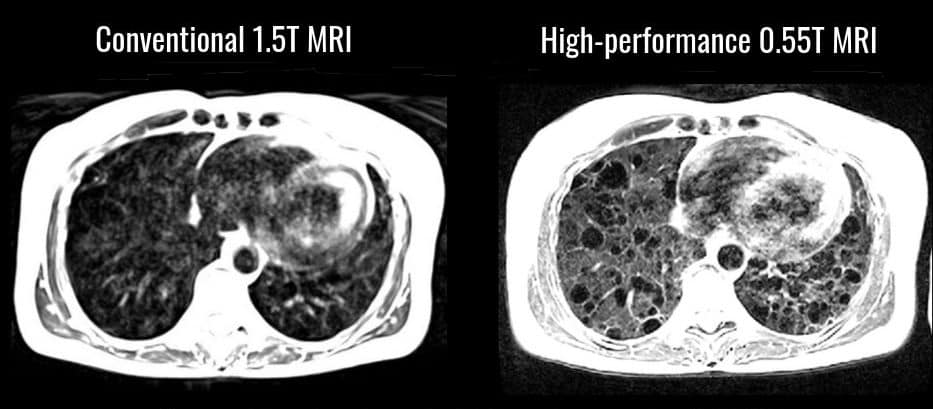
A high-performance, low magnetic-field MRI system can vastly improve the quality of lung images compared with a 1.5 T scanner. Developed by researchers at the National Institutes of Health (NIH) and Siemens, the low-field system is also more compatible with devices used in image-guided medical procedures and may prove safer for patients with pacemakers or defibrillators (Radiology 10.1148/radiol.2019190452).
Recent years have seen the introduction of MRI systems with higher magnetic field strengths, mainly for high-resolution imaging of the brain. Imaging at 1.5 T or 3 T can increase signal-to-noise ratio and resolution, but can also cause image distortion and artefacts at air–tissue interfaces. As commercial low-field MRI systems are generally not equipped with high-performance MRI hardware, the team propose that using a state-of-the-art MRI scanner, but at a lower field strength, may enable high-quality imaging of the heart and lungs.
To investigate this, the researchers modified a Siemens’ 1.5T MAGNETOM Aera MRI system to operate at 0.55 T, while maintaining the high-performance hardware and software needed to create high-quality images. They used the new imaging set-up to perform MRI examinations in 68 healthy volunteers and 15 participants with disease.
Importantly, the team found that metal devices such as interventional cardiology tools, which are at risk of heating with a high-field system, were now safe to use, heating up by less than 1°C. They demonstrated that MRI-guided heart catheterization (a procedure used to diagnose and treat some heart conditions) could be performed safely using commercial metallic guidewires.
“We continue to explore how MRI can be optimized for diagnostic and therapeutic applications,” says Robert Balaban, from the NIH’s National Heart, Lung, and Blood Institute (NHLBI). “The system reduces the risk of heating – a major barrier to the use of MRI-guided therapeutic approaches that have hampered the imaging field for decades.”
The team found that, compared with 1.5 T MR images, the 0.55 T scans reduced image distortion in the lungs, upper airway, cranial sinuses and intestines, due to improved field homogeneity. In patients with the lung disorder lymphangioleiomyomatosis, the low-field MR images showed lung cysts and surrounding tissues more clearly.
The researchers also examined the use of inhaled 100% oxygen to enhance signal intensity in lung tissue. They saw that inhalation of oxygen generated a signal enhancement of 19% at 0.55 T, compared with 7.6% at 1.5 T.
“MRI of the lung is notoriously difficult and has been off-limits for years because air causes distortion in MRI images,” explains first author Adrienne Campbell-Washburn. “A low-field MRI system equipped with contemporary imaging technology allows us to see the lungs very clearly. Plus, we can use inhaled oxygen as a contrast agent. This lets us study the structure and the function of the lungs much better.”
Campbell-Washburn suggests that this new generation of low-field MRI could change the way in which MRI is used in the future. “We can start thinking about doing more complex procedures under MRI-guidance now that we can combine standard devices with good quality cardiac imaging,” she says.



